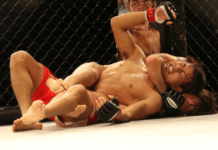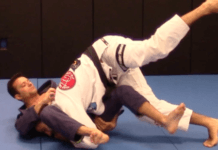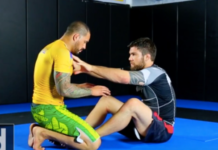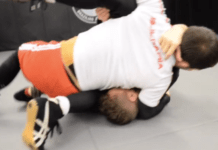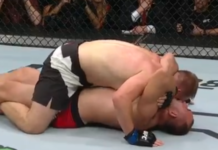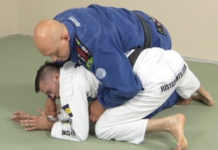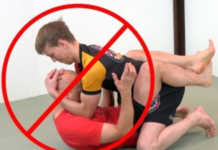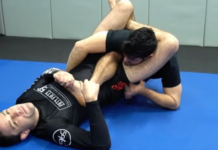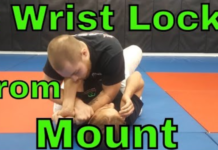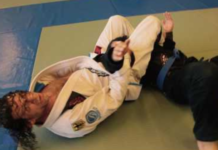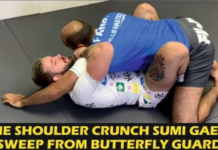Side control is a basic and one the most common position in Brazilian Jiu Jitsu if not even the most common. It’s also one of the most unfortunate positions to be in when you are the one pinned to the mat. So, we all kinda want to be on top. It offers you great control of your opponent and an amazing arsenal of attacks and possibilities from it. Below you will find all you need to know about BJJ side control attacks and positions, that works perfectly for both gi and no-gi.
What is side control?
BJJ side control (often also called side mount or cross mount) is a dominant position where the person on top is lying in such a way that her or his body is at a 90-degree angle to the opponents. In this position, upper body control through pressure and mechanical leverage is the most important part. In side control you just need to control your opponent, you should be focused on his or her neck/head or hips. As a position, side control is a fundamental pillar of Brazilian Jiu Jitsu basics. It is also often considered to be the most difficult position to escape from.
BJJ side control positions
Classic side control
To establish this position properly you need to be past your opponent’s legs. In this variation of side, control pressure is less important, you focus on becoming very compact. In this classic variation, your main goal is head control. To do that you should put one of your arms under your opponent’s head. Next, with your shoulder onto their chin you need to block their movement. The key point here is to stay tight. Your knee near the opponent’s head should touch your elbow at all time and the other one should be right up against his or her hips.
100 kilos position
Unlike the previous side control variation here the focus is completely on pressure. In this position being compressed if far more less important. The main difference between these two options is leg positioning. For the 100 kg side control, you to keep both your legs straight. The chest position is also very important here. You need to focus on keeping your chest right in the middle of the opponent’s torso. With your shoulder, you can also make pressure on hers or his jaw.
Kesa Gatame
This position is a Judo classic move. However, it can be also used in BJJ. To perform it you need to wrap one arm around your opponent’s head, with your opposite arm control his or hers near arm. In the end, splay your legs widely facing his head. In Brazilian Jiu Jitsu it is just a bit dangerous to stay in this position for too long because skilled opponents might get your back from it. That’s why reverse Kesa Gatame, also called twister side control was invented. It is the same position, you are just facing an opponent’s legs instead of the head.
BJJ side control attacks
Side control is one of the best positions to submit your opponent. There are many attack options from it, that work perfectly well even at the highest levels of competition. Below you will find some worth knowing submission options from BJJ side control.
Armbar
The best option to perform armbar from side control is to attack your opponent’s further arm. To establish it, you need to spin around him or her. You should be focused here on isolating the arm at elbow height. When you have it raise and pull the arm towards the ceiling. This is going to cause your opponent to turn towards you, allowing you to sit over their head and straight into the armbar position.
A common mistake people make when attacking the far side armbar from side control is they grip the triceps with the underhook. Doing this can allow the defender to flatten out. Instead of grabbing the triceps, try to grip the shoulder and place your elbow on their rib cage. This will make it simple to get your opponent on your side and hold him or her there as well.
Americana and Kimura
Americana, also known as the bent armlock or keylock is a common grappling submission mostly associated with the side control position. The person on top is controlling the opponent’s arm (bent in an “L” shape), by using a clever double wrist control which leaves the adversary’s elbow and shoulder joints vulnerable to the submission. To perform it you should pin down your opponent’s wrist to the mat with one of your hands. Then with another one, you need to go up under his or her arm gripping your own wrist. Next, drop your hip and lift your opponent’s arm while bringing his or her elbow to the hip for the tap.
For the Kimura, you’ll start in the same position. The difference between these two techniques is just on which way the forearm is pointing. If it is pointing downwards (towards the hip) the position is called a kimura, when the forearm is pointing up it is called an Americana. For example, when your opponent is defending Americana by rotating the hand down you can switch the technique you performing to Kimura. You just need to switch the position of your hips and spread pressure differently.
Paper cutter choke
BJJ side control is also perfect for choking techniques. The paper cutter choke is one of the most popular gi submissions here. To perform it you start from the classic side control position. The most important part here is to trap your opponent’s arm that’s near you between your legs.
Next, your goal is to thread your arm to the lapel on the back of your opponent’s neck. There, you should establish a four-fingers-in grip. After you have it, you need to switch your hips, like for a Kesa Gatame. This allows you to place your forearm across their neck, gripping the far side lapel. Switchback your hips and you will end up in a very deep choke that’s hard to defend.
Arm triangle
The arm triangle is another “classic” BJJ side control submission. It works really well, both for gi and no-gi. You start it from classic side control variation, with your arm under opponents head. The goal is trapping their further shoulder between your head and his or hers. The best way to achieve it is by using a palm to palm grip to take all space away. To finish the choke you need to go all the way through by placing a knee on belly.
Wristlock
Another thing that is easy to do from BJJ side control is attacking the wrists. No matter which side control variation you choose you can try to establish wrist locks with ease here. For example, you can perform this technique when your opponent attempts to push you off of them with their free arm. Most likely he or she will place their hand on your collar bone or neck area. Here, you need to drop your chin on top of your opponent’s wrist, forcing it to bend and locking it in place. Once you begin to apply the pressure of the hold, this will stop your opponent from retracting the arm. As a next step, move both your hands to the elbow of the trapped arm. As you pull up on their elbow, flaring it open, drive your collar bone forward. By this you will compress your opponent’s wrist, applying the wrist lock. For better effect, you can add additional pressure by moving your hips around your opponent’s head, just like the hands moving around a clock.
Check also escapes from the side control:

